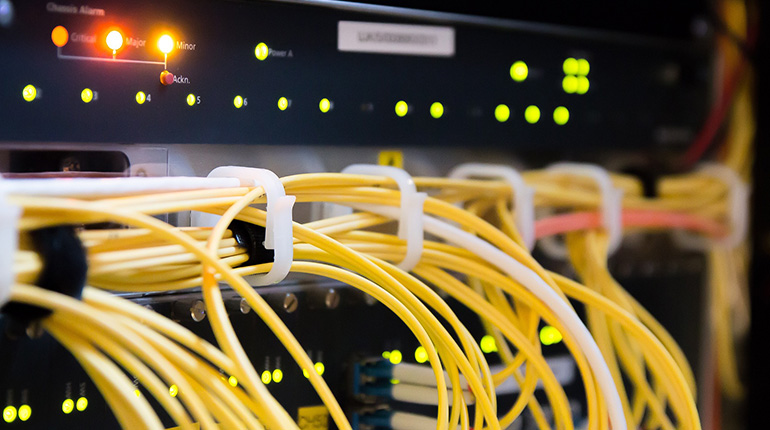Data centers are the backbone of modern technology. They provide crucial support for businesses and organizations across all industries. Optimizing every aspect of a data center carefully can ensure maximum performance and efficiency. The length and quality of cables can significantly impact data center performance.
Cable length and quality are pivotal elements that influence the efficiency and reliability of data center operations significantly. In this blog post, we will examine the intricacies of cable infrastructure within data centers. We’ll also explore the impact of cable length and quality on performance. Finally, we’ll discuss best practices for maximizing data throughput and minimizing latency.
Understanding Cable Infrastructure in Data Centers
Before exploring cable length and quality, understand their role in data center infrastructure. Cables serve as the conduits through which data travels between various components within the facility. This includes servers, switches, routers, and storage systems.
Data centers use distinct types of cables for connectivity. Examples include copper cables (including twisted pair and coaxial) and fiber optic cables. Each cable type offers specific advantages based on bandwidth, distance, and environmental conditions.
Maximizing Data Center Performance: Understanding the Impact of Cable Length and Quality
We have established that cable length and quality are crucial for data center performance. However, how do they affect it? Here are some reasons cable length and quality can impact data center operations:
1. Signal Degradation
As data travels through a cable, it encounters resistance, resulting in signal degradation. This means that the longer the cable, the weaker the signal becomes as it moves along its path. To compensate for this, data centers often employ repeaters or switches to boost signal strength and maintain data integrity.
Longer cables can also introduce latency. This can cause delays in data transmission and affect the overall performance of the system. This is particularly important for applications that require real-time data processing, such as financial transactions or video streaming.
2. Interference
Cables with inferior quality or insufficient shielding are more susceptible to electromagnetic interference (EMI) and radio frequency interference (RFI). External sources like power lines, radio signals, and other cables can cause interference. This results in data errors or complete signal loss. Furthermore, this can impact the reliability and performance of a data center significantly.
To mitigate the risk of interference, data centers must select and install cables with proper shielding. They should also separate cables from potential sources of interference.
3. Outdated Infrastructure
As technology advances, data center infrastructure must adapt to support higher speeds and increased bandwidth demands. Older or low-quality cables may not be capable of handling these requirements, leading to bottlenecks and decreased performance.
Updating cabling infrastructure is crucial for maintaining optimal data center performance. It helps keep up with the latest technology and avoids downtime.
4. Maintenance Challenges
In addition to affecting performance, cable length can also make it difficult to manage and maintain the infrastructure. Longer cables translate to more physical connectivity points, which increases the complexity of maintenance and troubleshooting. This can result in longer downtime and higher costs for data center operators.
As reliance on data centers for critical business operations increases, addressing cabling issues becomes crucial. You should ensure cabling does not hinder overall performance.
5. Latency
Cable length in data centers influences latency, thereby making it a critical factor. As data travels through longer cables, it takes longer to reach its destination, resulting in increased latency. This can have a significant impact on real-time applications that require low latency, such as video conferencing or online gaming.
Factors such as network congestion and processing delays can affect latency. Optimizing cable length plays a crucial role in minimizing it and improving performance.
Optimizing Infrastructure for Maximum Performance
Cable length and quality can affect data center performance in numerous ways. Therefore, it is critical to implement strategies to optimize infrastructure for efficiency. Here are some best practices for optimizing cable infrastructure in data centers:
1. Strategically Plan Cable Routes
Proper planning of cable routes can help minimize length and avoid unnecessary bends or twists that can affect signal quality. This also makes it easier to manage and maintain the infrastructure.
Use cable management techniques to maintain a neat and organized infrastructure such as cable routing, bundling, and labeling. This also helps with troubleshooting and identifying potential issues quickly.
2. Invest in High-Quality Cables
Do not cut corners when it comes to cable quality. Select cables from reputable manufacturers that offer high-quality, reliable solutions suited for data center environments.
Ensure all cables meet relevant industry standards and have proper shielding to minimize interference. Inspect and replace damaged or subpar cables regularly to maintain maximum performance.
3. Choose the Right Cable Type for Your Needs
Distinct types of cables offer varying levels of bandwidth and distance capabilities. You should select the right cable type based on your specific needs and requirements. Consider factors like data volume, transmission speed, and environmental conditions when choosing a cable type.
4. Regular Maintenance and Upgrades
Proper maintenance and upgrades are essential for ensuring optimal performance in data centers. This includes regularly inspecting cables, replacing damaged or outdated ones, and upgrading to more advanced solutions as needed.
Conclusion
Cable length and quality may seem like minor factors in data center operations. However, they can have a significant impact on overall performance. Understanding cable infrastructure and optimizing best practices helps data centers boost throughput and reduce latency. This leads to greater efficiency and reliability. Follow these tips to optimize your data center’s cables for maximum performance.
If you are looking for a trusted partner in cabling, then SMS Datacenter is here to help with everything. We provide connectivity and cabling solutions tailored to data center needs, ensuring high-quality and efficient performance. Our experts will design and implement a cabling system tailored to your needs. Contact us today to learn more. Email [email protected] or call 949-223-9240.

